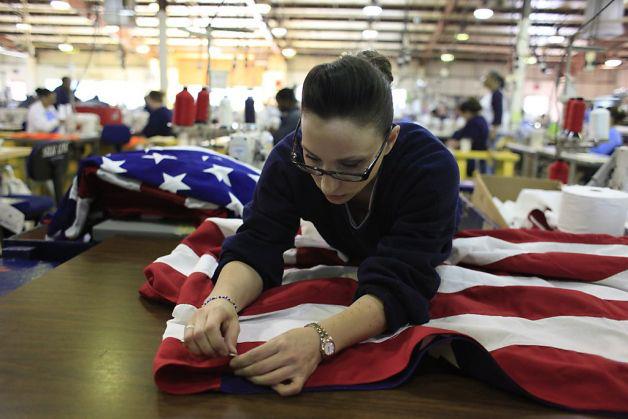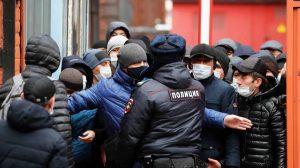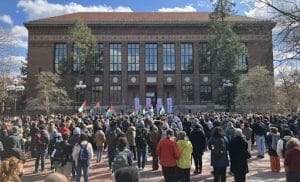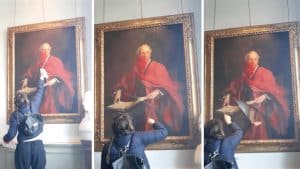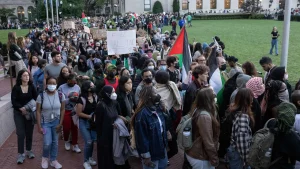Photo: An inmate works on an American flag while working in the Prison Industries Authority Fabrics program at the Central California Women’s Facility (disinfo.com).
The state of injustice that embodies the United States prison system is not a new concept. It has been written of, spoken about, and analyzed a hundred times over. Even so, as I walked through security no amount of knowledge could prepare me for the visceral disgust this experience would evoke.
As we walked past dilapidated buildings, one inmate called out, “Scott, you only smiling because you got visitors,” validating my suspicion that we were only going to see the pieces of the prison that the facility was proud of. In the fluorescent hallways of the prisoners’ educational center, signs posted on the walls read, “Parole is a privilege. Not a right.”
After a quick tour of the grounds and the “rehabilitative” programs available for the inmates, we were taken to the segregation units. A male C.O. walked by with keys clanging as he led a woman in shackles into the shower. The cells were barely big enough to fit a metal slab of a bed and a tiny toilet. The empty cell they let us look into still had a tray of rotting food in the corner, dirt covering everything, and tape patching up the disintegrating toilet seat. A woman in a segregation cell across the hall had her face pressed up against the glass of a tiny window, yelling, “I been in here since November 2011.”
When asked what it takes to get put in this deplorable warehouse of human beings, Lieutenant Davis explained that women get put in these cells “when they don’t act right or break the rules.” The minimum time spent in segregation is 30 days, but she said it could be longer depending on the severity of the offense, like taking drugs or fighting. Women can be locked in those cells for years. We saw the medical facilities where signs on the wall read, “Rape is not a part of your sentence.” The psychiatrist told us he treated about 740 out of the 800 women being held as prisoners in the facility.
Next, we were led to a facility that showcased what inmates described as the “best jobs in the house.” The inmates get to work at 6 AM and finish their day at 2 PM. We spoke to a woman named Kim who worked in the design shop where the inmates used sophisticated programming software to design the interior layouts of everywhere from the MVA to universities. She stated, “The tables you sit at at school, we probably designed those and the men at the male prison built them.” The work she did was truly impressive and she seemed proud of what she could do, but when asked about compensation for her work, she said she made $3.70 a day, and that was about the most you can make at this prison; most women were making $1.00 a day. She went on to say that the women in the design shop were usually women with very long stays and there were rarely openings because the pay was so high. The highest pay in the prison comes out to about 46 cents an hour.
We were led through a shop filled with women doing everything from data entry to legal aid to MVA registration. Some women designed and sent out posters and pamphlets that the Department of Health uses, and there was a distribution center for shipping.
When we entered the “cut and sew” shops, we were struck with the image of 4-6 women inmates sewing a 20×30 ft American flag. American flags of varying sizes were dispersed around the shop, seemingly serving as a visual reminder that sweatshops and slave labor are still very much alive in America. These women also made all of the uniforms used by government employees, including the uniforms worn by the COs. In the embroidery shop, a woman was embroidering paraphernalia for the Freemasons, a non governmental client.
The shop supervisor told us that the women in the cut and sew shop make a base pay of around $1.75 a day with miniscule compensation for productivity. There is a 10 cent raise every year with a $3.00 a day cap. He could not remember the base pay ever being raised in all the years he had worked at the prison. He told us there was huge amounts of turnover in this shop, and it wasn’t hard to imagine why.
A maximum security prison opened in 1879, the Jessup Correctional Institution several miles outside of Baltimore keeps about 800 women and 1,000 men in lockup. It has an annual budget of $38.5 million. According to the Institute for Criminal Policy Research, the female prison population has grown sharply and much faster than male prison population levels. Of the estimated 700,000 women in penal institutions worldwide, about 205,400 are in the United States. The country with the next highest total is China (total population of 1.36 billion) with 103,766 women in lockup.
In an era of mass incarceration charged by corporate and governmental capitalistic greed, US prisons have taken on the role of the modern-day sweat shop; legal slavery in the US. Currently, there are 2.2 million people incarcerated in the United States; more than any other country in number and per capita rates. This amounts to ¼ of the world’s prison population. According to the Center for Economic and Policy Research, incarceration rates prior to 1970 were about 100-200 prisoners per 100,000 people. After 1980, the numbers started skyrocketing. in 2008, there were 753 prisoners per 100,000 people, correlating with the prison privatization boom in the 80s.
This system of free labor has been immensely profitable for state and private sectors alike. Work is not an option for able-bodied prisoners. The punishment for refusing to work is often solitary confinement. As advertised on the Texas Department of Criminal Justice website, if a prisoner refuses to work, the prisoner will “remain in the cell 24 hours a day with no trips to the day room, commissary, or recreation yard. Meals are also eaten in the cell and personal property is taken away while on special cell restriction.” SCOTUS has ruled that prisoners do not have the right to join a union under the first amendment in the Jones v. North Carolina Prisoners’ Labor Union case.The United States has amassed an army of inmates forced to work for little to no pay, and the courts have ruled this exploitation acceptable. A 20th century Mississippi inmate wrote in a letter, “I’m beginning to believe that the U.S.A. stands for the Underprivileged Slaves of America,” a statement that still resonates today’s prison culture (Esposito and Wood, 1982).


